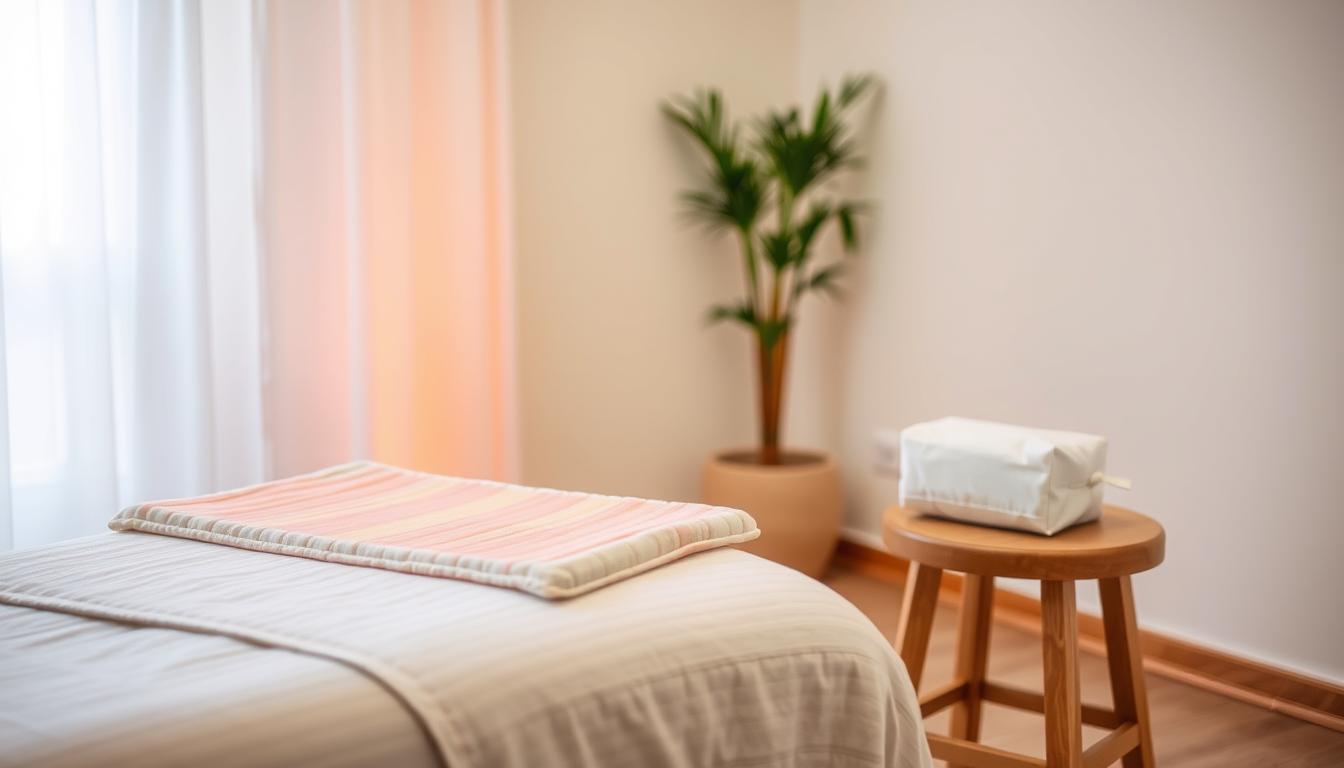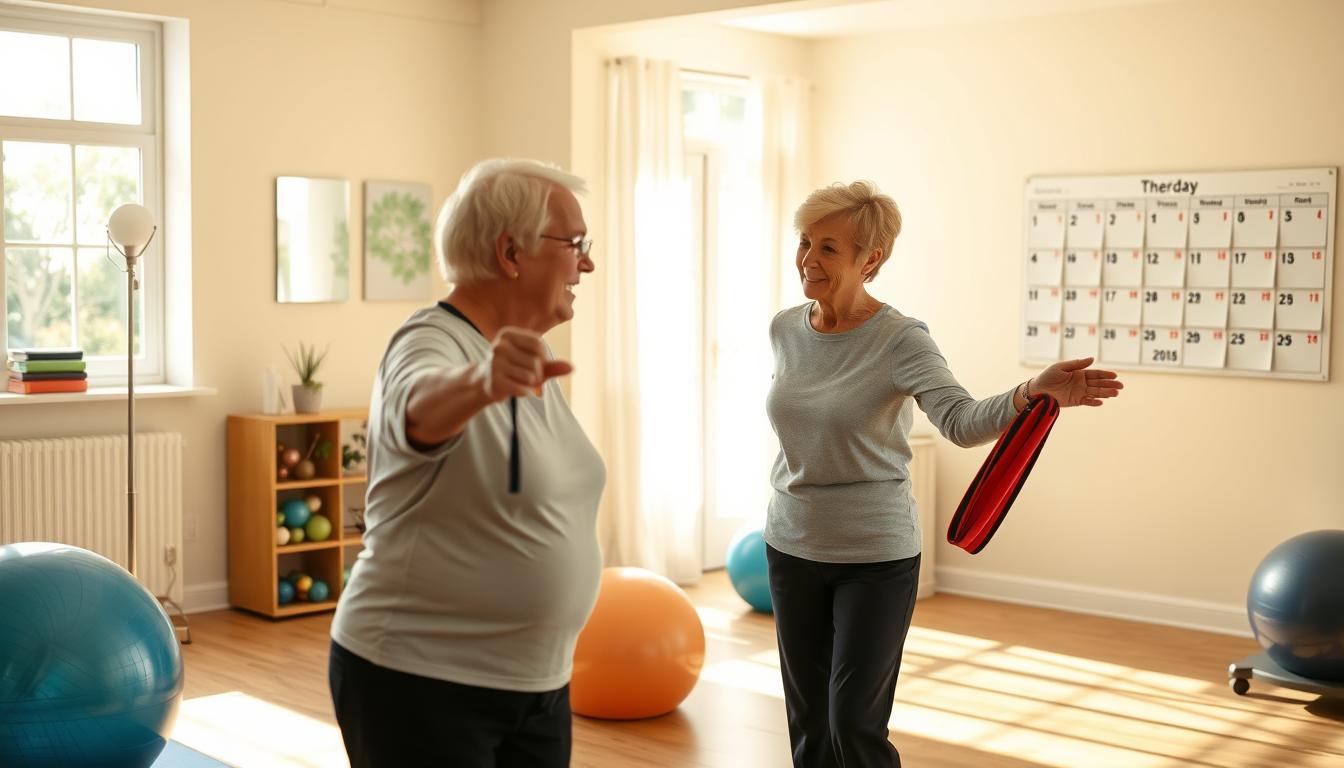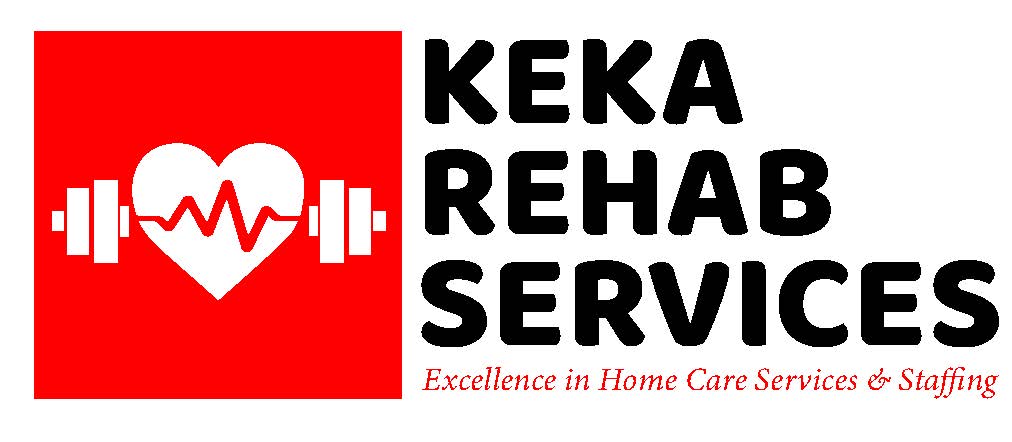Did you know that one in four older adults falls each year? This is a big problem. Physical therapy is vital for seniors. It helps them stay strong and independent.
Physical therapy helps seniors get stronger and move better. It also helps them balance and avoid falls. This is very important for older adults.
Physical therapy can be provided to seniors in many places, including hospitals, clinics, and even at home. Medicare often helps pay for this care.
Physical therapy is beneficial for seniors. It can manage health problems like osteoporosis and arthritis, after surgery and with brain disorders. Physical therapy helps seniors stay active and independent.
Key Takeaways
- One in four older adults falls annually, highlighting the need for physical therapy.
- Physical therapy builds strength, flexibility, and balance in seniors.
- Services are available in various settings, including at home.
- Medicare often covers physical therapy for elderly individuals.
- Physical therapy can manage chronic conditions and aid post-surgery recovery.
- Geriatric rehabilitation helps maintain independence and quality of life.
Understanding Geriatric Physical Therapy Fundamentals
Geriatric physical therapy helps older adults aged 60-90. It focuses on muscle strength and stability loss with age. Seniors often get weaker and less coordinated as they age.
What Makes Geriatric PT Different
Geriatric physical therapy builds strength and endurance in older adults. It starts after hospital stays for injuries or illnesses. The therapy helps with arthritis, balance issues, and Parkinson’s disease.
Key Benefits for Senior Health
Geriatric physical therapy offers many benefits for seniors. It boosts muscle strength, balance, and mobility and helps with daily tasks.
Exercise is key for seniors to stay mobile and happy. They should do at least 150 minutes of moderate activity weekly.
Treatment Settings and Medicare Coverage
Most therapy is done outpatient, covered by Medicare Part B. Home care is also covered. The therapy setting depends on the senior’s needs.
Medicare helps seniors get the therapy they need to stay healthy and independent.
Geriatric physical therapy is more than recovery. It improves life quality and prevents future injuries.
Physical Therapy for Elderly: Essential Components
Senior rehabilitation focuses on key elements to enhance overall well-being. Physical therapy for older adults targets strength, flexibility, endurance, and balance. These components work together to improve daily function and quality of life.
Strength training is a big part of senior rehabilitation. It uses body weight or light resistance to build muscle without straining joints, helping seniors perform everyday tasks more efficiently.
Mobility exercises, such as gentle stretches and range-of-motion activities, are vital for keeping seniors independent. They keep joints flexible and reduce stiffness, allowing seniors to move more freely.
Balance training is key to preventing falls. It includes exercises like standing on one foot or walking heel-to-toe, which improve stability and confidence in movement.
Endurance training is another vital part. It involves activities like walking or swimming to boost cardiovascular health. This helps seniors have energy for daily activities.
- Lower body stretches for flexibility
- Cardiovascular exercises for endurance
- Strengthening exercises for functional ability
- Balance exercises for fall prevention
Physical therapists tailor these components to each senior’s needs and abilities. They create programs that gradually increase in intensity as the senior progresses. This approach ensures safe and effective rehabilitation.
Core Exercise Programs for Senior Rehabilitation
Physical therapy for seniors focuses on core exercises. These improve strength, balance, and flexibility. They help keep seniors independent and healthy as they age.
Every year, experts and volunteers learn more about ageing. They find ways to keep seniors strong.
Strength Training Techniques
Strength training is key for seniors. It stops osteoporosis and keeps muscles and bones strong. Exercises like the Pallof Press and Deadlift work the core for stability.
Balance and Coordination Exercises
Balance exercises lower fall risks in older adults. They boost coordination and mobility. This keeps seniors independent in daily life.
Exercises like Russian Twists and Turkish Sit-Ups improve balance. They are great for seniors.
Flexibility and Range of Motion Work
Flexibility training keeps joints healthy and prevents injuries. Stretching the lower back and hamstrings helps a lot. Core exercises like Planks also improve flexibility and strength.
Endurance Training Methods
Endurance training keeps the heart healthy in seniors. Tufts University experts suggest aerobic activities and strength exercises twice a week. These can be incorporated into daily routines and home workouts, boosting mobility and endurance.
Fall Prevention and Safety Strategies
Keeping seniors safe from falls is very important. Physical therapy helps a lot in this area. One in four people over 65 falls every year.
Balance training is key to preventing falls. Physical therapists create exercises to help with standing, walking, and changing direction. These might include:
- Static balance work
- Weight-shifting exercises
- Marching in place
- Tandem walking
Strength training is also essential. Doing sit-to-stand exercises 10 times twice a day can make your legs stronger. This can help prevent falls.
Checking the environment is also essential. Physical therapists teach seniors how to use mobility aids. They also suggest making home changes to avoid dangers. Good lighting and removing things that could cause falls can help a lot.
It’s essential to have someone with you when doing balance exercises. Always talk to your doctor before starting new exercises or changing your medicine. With the right help, you can stay safe and active.
Pain Management and Chronic Condition Support
Physical therapy is key for seniors with pain and chronic conditions. As we get older, our bodies need special care.
Arthritis Management
Arthritis is common in older adults, causing joint pain. Physical therapists use exercises to help joints move better and hurt less. About 50% of adults over 65 have chronic pain, with 70% feeling pain in more than one place.
They might suggest swimming or cycling to help with arthritis. These activities keep you fit while easing symptoms.
Osteoporosis Care
Physical therapy for osteoporosis includes safe exercises to keep bones strong. These exercises help bones and muscles get stronger. This lowers the chance of breaking bones.
Therapists also teach how to stand and move right. This helps avoid falls and injuries.
Post-Surgery Recovery
Physical therapy is vital after surgery. Therapists make unique plans to help patients move better and avoid problems. These plans include exercises, manual therapy, and ways to manage pain.
The Centers for Disease Control recommends that adults exercise for at least 150 minutes weekly, including two days of muscle-strengthening activities. For seniors with chronic pain, programs like Michigan State University Extension’s PATH can be very helpful.
Good pain management and support can help seniors live better. Before starting any new exercise, always talk to a doctor.
Specialized Treatment Approaches
Physical therapists help seniors move better and feel less pain. They use unique techniques to meet the needs of older adults, improving their quality of life.
Manual Therapy Techniques
Manual therapy is hands-on therapy that helps joints move better and hurt less. Therapists gently stretch muscles to increase flexibility, helping seniors with arthritis or stiff joints move more quickly.
Heat and Cold Therapy
Heat therapy relaxes muscles and improves blood flow. It’s used before exercises to warm up tissues. Cold therapy reduces swelling and numbs pain in acute injuries. These methods are helpful for self-care at home.

Therapeutic Exercise Programs
Therapeutic exercises are made for each senior’s needs. They might include water exercises, resistance band training, and activities to improve balance and strength. Regular exercise releases endorphins, boosting mood and reducing depression symptoms in older adults.
These unique methods improve seniors’ health. Physical therapists help older adults stay independent and enjoy a better quality of life by combining manual therapy, heat and cold treatments, and targeted exercises.
Home Exercise Programs and Self-Management
Physical therapists create unique home exercise plans for the elderly. These plans help maintain strength, flexibility, and balance, which is key for them to keep moving and stay independent.
Research shows that digital health programs and home exercises can greatly benefit older adults. They can help them become stronger, fall less, and feel better overall.
- Using the correct body mechanics for everyday tasks
- Managing pain well
- Using assistive devices correctly
But, most Americans over 65 don’t exercise enough. They should do 30 minutes of moderate activity daily and muscle-strengthening twice a week.
Many therapists use technology to help. They use videos and apps to guide and check on exercises, making sure seniors do the exercises correctly and keeping track of their progress.
Doing regular exercises at home can help. Older adults get better at moving, balancing, and doing daily tasks. Adding these exercises to their daily routine allows seniors to stay independent and feel better.
Maintaining Independence Through Physical Therapy
Physical therapy helps seniors stay independent. It makes them move better and do daily tasks. This keeps them free and happy.
Activities of Daily Living (ADL) Support
ADL support is key in physical therapy for seniors. Therapists help with strength and coordination for tasks like dressing and eating, allowing seniors to do things independently.
Mobility Enhancement Strategies
Mobility is essential for seniors to stay independent. Physical therapists teach new ways to move and show how to use tools to help.
Studies show that personal physical therapy lowers fall risk in seniors.
Environmental Modifications
Keeping the home safe is vital for seniors. Physical therapists check the house and suggest changes. They might suggest grabbing bars or removing things that could cause falls.
Physical therapy helps seniors greatly. It improves their daily tasks, mobility, and safety. Seniors who receive unique physical therapy fall less and move and strengthen more.
Treatment Frequency and Progress Monitoring

Physical therapy is vital for seniors. You will attend therapy two to three times a week, and each session lasts 30 to 90 minutes.
Your therapist will make a plan just for you. They will look at what you need and what you want to achieve.
How long you will be in therapy can change. It depends on your injury, how bad it is, and your health. For some injuries, it can take 6 to 8 weeks to heal. But your program might last longer if needed.
It’s essential to check how you’re doing in therapy. Your therapist will look at:
- Pain levels
- Range of motion
- Strength gains
- Overall functional improvements
They will use this information to change your therapy plan if necessary. Sticking to your therapy plan is very important, and doing your exercises at home is a big part of it.
Studies show that therapy at home can work just as well as in a clinic. A 2016 study found that home therapy worked as well as clinic therapy after knee surgery. This shows how important it is to keep up with your therapy, no matter where you do it.
Your therapist might suggest doing more challenging exercises. They want to help you get stronger. They will also make sure you’re doing the exercises right. This enables you to avoid getting hurt and works your muscles better.
Conclusion
Physical therapy is key for seniors. It helps them move better, feel less pain, and stay independent. It tackles issues like arthritis and balance problems, keeping seniors happy and healthy.
Geriatric rehabilitation is crucial. It helps prevent diseases, keeps the mind sharp, and lowers the chance of falls. As there are more seniors, we’ll need more physical therapy.
Physical therapists say seniors should exercise extensively. They need 150 minutes of aerobic activity and muscle-strengthening exercises twice a week. This helps their heart, balance, and strength. With the right plan, seniors can live longer.
FAQ
What is geriatric physical therapy?
Geriatric physical therapy helps older adults (65 and up) by building strength and improving mobility. This helps seniors stay independent and live well.
How does physical therapy benefit the elderly?
It helps seniors move better, hurt less, and prevent falls. It also boosts balance, strength, and flexibility, which helps them perform daily tasks independently.
Where can elderly patients receive physical therapy?
Physical therapy can be provided to seniors in many places, including hospitals, clinics, nursing homes, and even at home.
Does Medicare cover physical therapy for seniors?
Yes, Medicare often covers physical therapy for seniors. Part B covers outpatient and home care. Part A covers inpatient services. Check your plan for details.
What types of exercises are included in geriatric physical therapy?
The exercises used in geriatric physical therapy vary. They include strength training, balance exercises, and flexibility work, which use body weight, light weights, or special equipment.
How does physical therapy help prevent falls in the elderly?
It prevents falls by improving balance and strength. Therapists also check the environment, teach how to use aids, and suggest home changes.
Can physical therapy help manage chronic conditions in seniors?
Yes, it helps with chronic conditions like arthritis and osteoporosis. Therapists use exercises to improve function and reduce pain.
What is a home exercise program for the elderly?
It’s a set of exercises created by a physical therapist for seniors to do at home. The exercises maintain strength, flexibility, and balance, and videos or apps help.
How often should seniors attend physical therapy sessions?
Seniors usually go two to three times a week. Sessions last four to twelve weeks, depending on their condition and progress.
How does physical therapy support Activities of Daily Living (ADL) for seniors?
It improves strength and coordination for daily tasks. Therapists teach how to do things correctly and suggest equipment to help with independence.
What is manual therapy in geriatric physical therapy?
The therapist provides a hands-on treatment that improves joint mobility and reduces pain. Techniques include joint mobilization and soft tissue massage.
